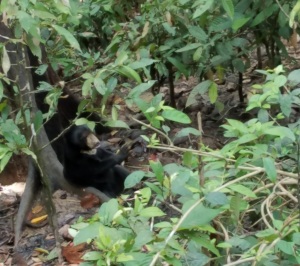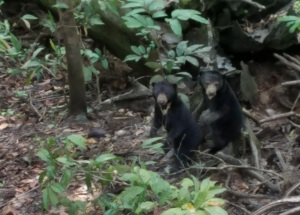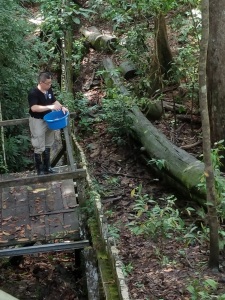Commonly recognized for their small stature and unique chest markings, Malayan Sun Bears (Helarctos malayanus) are found across Southeast Asia, including the forests of Sabah, Borneo. The bears found here are a subspecies known as Bornean Sun Bears and are half the size of their mainland counterparts. On June 12, we were lucky enough to get an up-close view of these incredible omnivores at the Bornean Sun Bear Conservation Centre (BSBCC) in Sepilok, Sabah. The BSBCC was founded by CEO Dr. Hon Wong Siew Te in 2008 with the goal of promoting animal welfare, environmental education, and rehabilitation. The center consists of several raised viewing platforms linked by walkways, which offer a glimpse into the life of the bears roaming each large enclosure. Spotting scopes are set up for viewing of bears napping in faraway trees and educational posters and signs answer questions about Sun Bear habitat, diet, and life cycle.

During our visit, Dr. Wong took time out of his busy schedule to give us a brief history of the center and to talk about current issues facing these small bears. Currently, there are 44 bears living in the center. Most bears are rescued as cubs from situations where they are poorly treated or held in captivity. The biggest threats that these bears face include habitat loss, being held in captivity, and being poached for their meat or body parts. As a forest dependent species, the sun bear faces serious dangers from unsustainable deforestation practices and land use patterns. Although they are often found in secondary growth forest, they cannot survive in agricultural areas. This often pushes them closer to humans, making it easier for them to be captured and held as pets. Like other large mammals, sun bears become injured, malnourished, and stressed when held in small cages. Many bears at the center have been rescued from these situations. Additionally, sun bears are continuously poached for their meat and body parts, which are used as medicine or decoration. The species has been labelled a “totally protected” species under the Sabah Wildlife Conservation Enactment of 1997, but poaching continues in many areas.

The goal of the center is to rescue Sun Bears from bad situations and rehabilitate them so they learn normal feeding and foraging behaviors. During our visit, we were lucky to spot several bears engaged in proper bear-like behaviors. At a distance, we observed a larger bear asleep in a tree, far from the viewing platform. We also observed as three young bears were fed by Dr. Wong and his staff. They learned foraging behaviors like digging and sniffing as they sought out the bananas and other fruit tossed in different parts of the enclosure.

Before we left the center, we stopped in the gift stop, where a Sun Bear was adopted in the name of USF. The “Adopt a Bear” program helps fund center costs and engage visitors by giving them information about specific bears living at the center. USF is now a sponsor of Cerah the adult female Bornean Sun Bear.
Terima Kasih,
Theresa Keith
